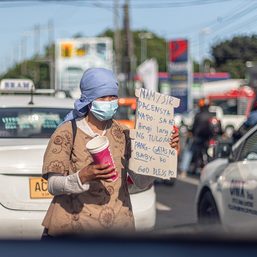SUMMARY
This is AI generated summarization, which may have errors. For context, always refer to the full article.
![[Dash of SAS] Workforce drought across continents and its impact on the Philippines](https://www.rappler.com/tachyon/2024/01/Workforce-Drought-Across-Continents-and-Its-Impact-on-the-Philippines.jpg)
An aging population and low birth rates are causing a seismic workforce drought. Many developed countries are scrambling to quell the tremors by loosening visa restrictions to attract people from countries like the Philippines, which is a primary source of migrant labor.
The tremors caused by a massive workforce shortage is echoing across the globe. From the fruit farms in Italy and Portugal where olives and fruits await their harvest, to the bustling restaurants in tourist spots grappling with a scarcity of hands. The clatter reverberates in the United Kingdom (UK) where the fallout from Brexit and the pandemic severed labor ties that went from European Union member states to the UK. Luggage piled up in London’s Heathrow Airport and construction projects are stalled because there are simply not enough people to do the job.
Underpinning this workforce vacuum is a common thread — an aging population and declining birth rates across many developed countries. The economic powerhouse status of the G7 countries (the world’s richest countries) is under threat because there are not enough people to keep the wheels of the economy running.
As a result, even the countries with the tightest immigration rules are loosening their grip on migration policies to let in workers skilled in anything from plumbing and health care to tech. Germany just announced an easier path to citizenship. Italy is expediting and increasing agricultural worker visas and the UK has added more categories to its shortage occupation list.
To be clear, the UK and Italy are among the loudest European countries, touting an anti-irregular migration policy, stopping boats that carry migrants and impounding humanitarian ships that try to rescue them. The relaxation of their immigration policies for certain occupations does not soften their hardcore stance which has been widely criticized by human rights groups across the world.
Implications on the Philippines: The changing face of the OFW
As a global source of migrant labor, the scramble to plug labor gaps has many implications on the Philippines.
According to government statistics, the largest number of overseas Filipino workers are in the 30-39 age bracket.
However, a large segment also belong to the younger age group between 25-29.
The data is indicative of the changing profile of the OFW as the demand for digital expertise grows. From being someone who is married or with children and pushed by limited employment opportunities to work abroad, the face of the OFW will increasingly became single individuals who are driven by adventure and the promise of career advancement to try making it abroad.
In the city of Berlin where I am currently based, for example, Filipinos contribute their unique flair to the international mosaic of talent in the city which is evolving into a start-up hub, expanding its reputation as Europe’s nightlife capital. In many of the start-ups in Berlin, the language spoken is English because of the international employees who outnumber the locals.
Many of the Filipinos here work in diverse occupations as scientists, digital content strategists, and data scientists. Many are single and have decided to move abroad more as a choice rather than a necessity. With the opening of the European Union Job Pool — which has been called Tinder for job seekers and employers — more Filipinos will be enticed to explore careers abroad. The best and much needed Filipino talents at their most productive years will power the economies of other countries, leaving the Philippines with its own kind of workforce shortage — one of expertise.
Human trafficking will increase
The looming workforce exodus from the Philippines also presents a darker prospect: the increased risk of human trafficking and forced labor. As opportunities abroad beckon, traffickers will sense this as an opportunity to exploit migrant workers, especially those working in vulnerable and high-risk sectors like agriculture and domestic care.
The government must resist its common knee-jerk reaction to institute deployment bans and roll out stricter policies that are not well thought out in their bid to counter human trafficking. For example, as a response to prevent the trafficking of migrant Filipino women, the age for working abroad as a household service worker has been raised to 24. This minimum age policy, which lacks basis, only pushes migration through underground channels where traffickers and scammers offer a promise of escape.
Balancing labor protection and the right to migrate
The demand for expertise across both white and blue jobs and the relaxed immigration policies to attract talent stands to run counter with the Philippines’ current bureaucratic recruitment policies to strike a delicate balance between labor protection and global labor market competitiveness.
For instance, a friend of mine was transferred by her existing employer to the company’s office in Berlin. What is important to note is that she was still working for the same employer who she has been working with for the last couple of years. She was simply going to be transferred to their European office.
She had to go through the same bureaucratic process of numerous visits to the government’s labor office and securing the necessary paperwork.
This delayed her departure for weeks. Other colleagues who were transferred from other countries to the European office were able to move a lot faster. This positions her and other Filipinos as a much less competitive and attractive candidate for such opportunities.
Not just about leaving but also returning
Overall, the government must transform its existing migration policies to reflect migration as not just a one-way journey but as a cyclical exchange of skills and experiences. It’s not just about leaving; it’s about returning not just physically but through ways that OFWs can give back and share skills that can be used to catalyze economic development and the uplift the lives of other Filipinos. This way, rather than just looking at labor migration as a source of remittances, migration becomes a fountain of economic growth for the nation. – Rappler.com
Ana P. Santos is an investigative journalist and writer who writes about the intersections of gender, sexuality, and labor migration. She completed a postgraduate degree in Gender (Sexuality) from the London School of Economics and Political Science as a Chevening Scholar. Follow her on Instagram at @anaallsaints.
1 comment
How does this make you feel?

![[DASH of SAS] The Philippine labor export policy needs an overhaul – stat](https://www.rappler.com/tachyon/2024/01/tl-ph-labor-export.jpg?fit=449%2C449)










![[OPINION] Unpaid care work by women is a public concern](https://www.rappler.com/tachyon/2024/07/20240725-unpaid-care-work-public-concern.jpg?resize=257%2C257&crop_strategy=attention)




I agree with Ana Santos: “… the government must transform its existing migration policies to reflect migration as not just a one-way journey but as a cyclical exchange of skills and experiences.” In addition, I also agree with the idea that “migration becomes a fountain of economic growth for the nation.” But there is a social danger here. What if those migrants realize that the country in which they are working has a better government and offers a better future for their children? It will indeed be a one-way journey for them.